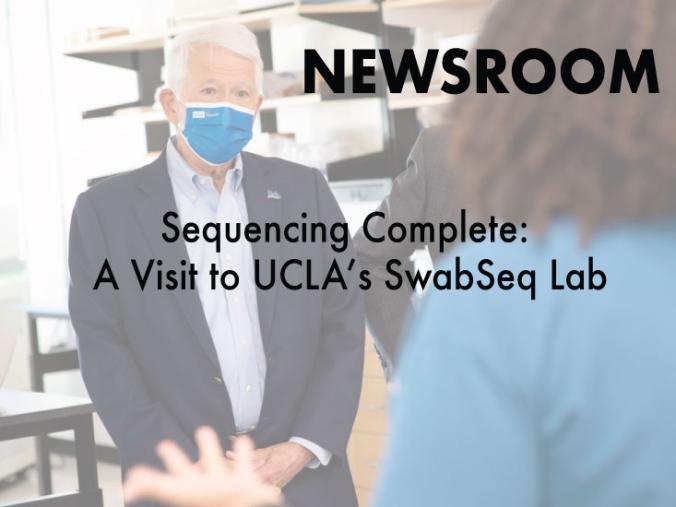Sequencing Complete: A Visit to UCLA’s SwabSeq Lab

By Delan Bruce | Newsroom
For UCLA, with a community of more than 80,000 students, faculty and staff, offering accurate and quick COVID-19 testing has been a critical part of campus operations during the pandemic.
When it became operational in October 2020, the UCLA SwabSeq Lab began testing about 1,000 samples every week for COVID-19. During peak times of the year — such as campus housing move-in week in mid-September or the current omicron surge — the lab processes up to 50,000 samples a week.
On Nov. 29, Chancellor Gene Block and other campus leaders took a tour of the lab’s facilities and saw firsthand what goes into its vitally important work. Leading the tour was Rachel Young, laboratory supervisor and clinical laboratory scientist for the COVID-19 SwabSeq lab. Also on hand to talk the visitors through the lab were Valerie Arboleda M.D. ’14, Ph.D. ’14, assistant professor of pathology and human genetics; Joshua Bloom ’06, a research scientist in human genetics and an adjunct assistant professor in computational biology; and Eleazar Eskin, chair of computational medicine, a department affiliated with both UCLA Samueli School of Engineering and the David Geffen School of Medicine at UCLA.
SwabSeq’s test is free, easy to do and accessible to everyone with a BruinCard: Simply swipe your card at any of the 13 vending machines, register using your phone, then spit into a small test tube and deposit your sample in the drop box. You’ll be notified of the results in 24 to 36 hours.
SwabSeq attaches a piece of DNA that acts like a molecular barcode to each person’s saliva sample, allowing scientists to combine large batches of samples together in a sequencing machine and quickly identify those who have the virus.
“For mass testing, it’s highly innovative,” Block said of the lab’s sequencing technology. “It gives opportunities to a lot of large organizations, like UCLA, to test that wouldn’t have existed before. The turnaround is quick, the test is simple and self-administered — it has all the advantages of a technology that’s very easy to implement.”
The lab’s DNA–sequencing methods can also offer insights that could potentially limit the danger of new diseases, apart from COVID-19, as they emerge. In the future, when COVID-19 becomes endemic, there are plans for the lab to develop a panel of respiratory tests that can detect the full sequence of a new virus before it gets out of hand — a process that wasn’t in place two years ago when COVID-19 arrived.
Initially contained within one room, the lab now occupies an entire floor in the south tower of the Center for Health Sciences. Four robots work on various stages of the testing process, performing automated tasks in support of the 16 human staff members and undergraduate students, whose efforts are now focused on further increasing capacity.
In addition to testing for the UCLA community, the lab handles nasal swab and saliva samples for the Los Angeles Unified School District, Pepperdine University, UC Santa Barbara and other clients.
“I was extremely impressed,” said Block after the tour. “This lab was put together very quickly. The fact that it’s scaling up so dramatically, with new equipment and automation, is a tremendous testament to the commitment of all the folks working here. I know this requires a huge amount of work on everyone’s part, and it’s helping the whole campus — and the whole society.”
